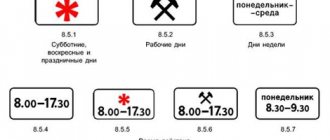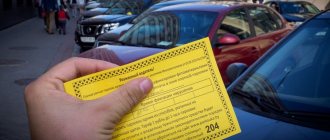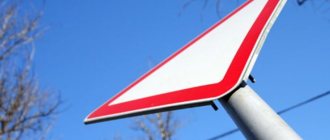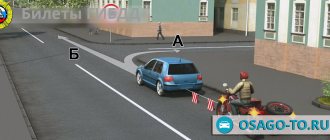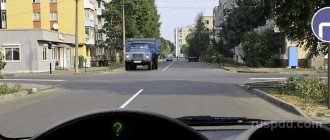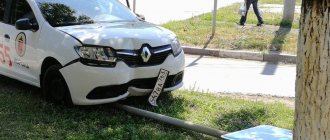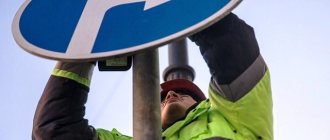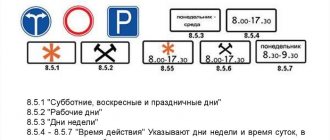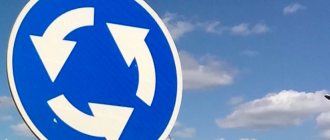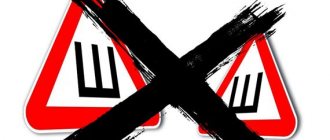Sign on traffic rules tickets
This sign:
More details
Are you allowed to enter the bridge at the same time as the motorcycle driver?
More details
This sign:
More details
Are you allowed to enter the bridge at the same time as the motorcycle driver?
More details
Priority signs are a special category of traffic rules signs that inform traffic participants about the order of crossing intersections, all kinds of roadways or sections of road, the width of which allows only one car to pass. Priority signs have their own specific images, which should be remembered and be able to distinguish from each other. Thus, the category of priority signs includes signs that will notify drivers about the junction of a secondary road, that they cannot cross the intersection without stopping, and about the priority of certain drivers moving towards each other.
Sign 2.6 - The right of way for oncoming traffic is established immediately in front of the very section of the road on which they operate. Knowledge and compliance with traffic rules priority signs is mandatory for every road user, since ignorance of the designation of a particular sign can lead to various types of accidents and the formation of large congestions on a section of the road.
When studying priority signs, you should use various materials that will illustrate the situation in which these signs will work, as this will help you remember them faster, because priority signs, unlike other traffic rules signs, do not have a common range and theme and are maximally different from each other. from each other, making them one of the most difficult categories to learn.
When you have to resort to oncoming traffic
There are many situations when you have to resort to oncoming traffic; they can be provoked by:
- narrow arches and passages in courtyards;
- crossing with another car at an intersection when the desire of its driver and yours coincided to turn left;
- repair or obstruction on one of the lanes;
- ascents and descents;
- cars parked on both sides;
- accident on the road.
It’s up to you to decide how to behave at intersections when you intend to turn in one direction: you can pass with the right sides of the car: by turning left, without matching, or with the left, so that the cars turn after they have caught up. If the intersection has a dividing strip, it is worth passing on the left side so that none of the cars ends up in the oncoming lane.
It is more difficult to pass in a closed area adjacent to houses, since there is no clear guidance for this and there is no control, as on the roadway. Meanwhile, the situation is not simple: in a narrow area, cars are trying to maneuver, and there is a lot of interference around, and someone has to reverse. In order to safely miss an oncoming car, the one whose path will be shorter must give way in the yard. You can make a preliminary agreement with the driver coming towards you if you are not a very confident motorist.
If cars are driving along the road, and something is discovered on one side that forces the driver to turn into someone else’s lane, then it is he who must yield - the one who is avoiding the obstacle.
When overtaking, and everyone knows this, the overtaking person must let oncoming cars pass. But there are difficult situations when you become the victim of an irresponsible driver who decides to break the rules and rushes towards you. In this case, you need to do everything possible to avoid a head-on collision - it is better to pull over to the side of the road or deviate from the lane and allow it to hit the sides of your car. Under no circumstances should you overtake other cars in a tunnel or in an area marked with a “No Overtaking” sign (a circle with a red outline and a white background on which a black and a red car are drawn). If you are driving behind a truck that is blocking your view, then look at its turn signals: drivers of large vehicles usually use them to signal those behind them. The left turn signal on warns you of the danger of colliding with another car if you enter its lane, and the right one indicates a favorable moment for maneuver.
Repairs started on the road, or the scene of an accident fenced off by the police, can either obey the general rule of avoiding obstacles (the person passing gives way) or overtaking, or be regulated by temporary signs or manually by the police. Be careful: temporary signs (with a yellow background) take precedence over permanent ones, so follow them.
When going up and down, the one going down gives way, as he has a better view of what is happening on the road. The angle formed on the slope and the degree of its danger are reflected in warning signs: they are made in the form of triangles with a white background and a red outline, which depict a slide or descent, as well as the percentage of the slope. If there are no signs, then this rule does not apply - this place is not considered an ascent/descent.
On historically narrow roads there are usually special signs explaining who must yield to whom. We'll look at them below.
Other organizations
Sign 8.24 - Tow Truck Operating
Indicates that a vehicle is being detained in the coverage area of road signs 3.27 - 3.30.
Sign 8.23 - Photo and video recording
Applicable with signs 1.1, 1.2, 1.8, 1.22, 3.1 - 3.7, 3.18.1, 3.18.2, 3.19, 3.20, 3.22, 3.24, 3.27 - 3.30, 5.14, 5.21, 5.27 and 5.31 , as well as with traffic lights. Indicates that in the coverage area of a road sign or on a given section of the road, administrative offenses can be recorded using automatic special technical means that have the functions of photography, filming and video recording, or by means of photography, filming and video recording.
Sign 8.22.3 - Obstacle
They indicate the obstacle and the direction to avoid it. Used with signs 4.2.1 - 4.2.3.
Sign 8.22.2 - Obstacle
They indicate the obstacle and the direction to avoid it. Used with signs 4.2.1 - 4.2.3.
Sign 8.22.1 - Obstacle
They indicate the obstacle and the direction to avoid it. Used with signs 4.2.1 - 4.2.3.
Sign 8.21.3 - Type of route vehicle
Used with sign 6.4. They indicate where vehicles are parked at metro stations, bus (trolleybus) or tram stops, where transfer to the appropriate mode of transport is possible.
Sign 8.21.2 - Type of route vehicle
Used with sign 6.4. They indicate where vehicles are parked at metro stations, bus (trolleybus) or tram stops, where transfer to the appropriate mode of transport is possible.
Sign 8.21.1 - Type of route vehicle
Used with sign 6.4. They indicate where vehicles are parked at metro stations, bus (trolleybus) or tram stops, where transfer to the appropriate mode of transport is possible.
Sign 8.20.2 - Type of vehicle bogie
Used with sign 3.12. Indicate the number of adjacent axles of the vehicle, for each of which the mass indicated on the sign is the maximum permissible.
Sign 8.20.1 - Type of vehicle bogie
Used with sign 3.12. Indicate the number of adjacent axles of the vehicle, for each of which the mass indicated on the sign is the maximum permissible.
Sign 8.19 - Class of dangerous goods
Indicates the number of the class (classes) of dangerous goods according to GOST 19433-88.
Sign 8.18 - Except for disabled people
Indicates that the sign does not apply to motorized wheelchairs and cars on which the “Disabled” identification sign is installed.
Sign 8.17 - Disabled people
Indicates that the effect of sign 6.4 applies only to motorized wheelchairs and cars on which the “Disabled” identification sign is installed.
Sign 8.16 - Wet surface
Indicates that the sign applies to the period of time when the roadway surface is wet.
Sign 8.15 - Blind pedestrians
Indicates that the pedestrian crossing is used by the blind. Used with signs 1.22, 5.19.1, 5.19.2 and traffic lights.
Sign 8.14 - Traffic lane
Indicates the traffic lane or bicycle lane covered by a sign or traffic light.
Sign 8.13 - Direction of the main road
Indicates the direction of the main road at an intersection.
Sign 8.12 - Dangerous shoulder
Warns that going to the side of the road is dangerous due to repair work being carried out on it. Used with sign 1.25.
Sign 8.11 - Maximum weight limit
Indicates that the sign applies only to vehicles with a permissible maximum weight exceeding the maximum weight indicated on the plate.
Sign 8.10 - Vehicle inspection area
Indicates that on the site marked with sign 6.4 or 7.11 there is an overpass or inspection ditch.
Sign 8.9.1 - Parking for parking permit holders only
Indicates that only vehicles whose owners have a parking permit, obtained in accordance with the procedure established by the executive authorities of a constituent entity of the Russian Federation or local self-government bodies and valid within the territory whose boundaries are established by the relevant executive authorities, can be placed in a parking lot marked with sign 6.4. subject of the Russian Federation or local government bodies.
Sign 8.9 - Limitation of parking duration
Indicates the maximum duration of a vehicle's stay in a parking lot marked with sign 6.4.
Sign 8.8 - Paid services
Indicates that services are provided for a fee only.
Sign 8.7 - Parking with the engine not running
Indicates that in a parking lot marked with sign 6.4, parking of vehicles only with the engine not running is permitted.
Sign 8.6.9 - Method of parking a vehicle
Plaque 8.6.1 indicates that all vehicles must be parked parallel to the edge of the roadway. Plates 8.6.2 - 8.6.9 indicate the method of parking cars and motorcycles in sidewalk parking.
Sign 8.6.8 - Method of parking a vehicle
Plaque 8.6.1 indicates that all vehicles must be parked parallel to the edge of the roadway. Plates 8.6.2 - 8.6.9 indicate the method of parking cars and motorcycles in sidewalk parking.
Sign 8.6.7 - Method of parking a vehicle
Plaque 8.6.1 indicates that all vehicles must be parked parallel to the edge of the roadway. Plates 8.6.2 - 8.6.9 indicate the method of parking cars and motorcycles in sidewalk parking.
Sign 8.6.6 - Method of parking a vehicle
Plaque 8.6.1 indicates that all vehicles must be parked parallel to the edge of the roadway. Plates 8.6.2 - 8.6.9 indicate the method of parking cars and motorcycles in sidewalk parking.
Sign 8.6.5 - Method of parking a vehicle
Plaque 8.6.1 indicates that all vehicles must be parked parallel to the edge of the roadway. Plates 8.6.2 - 8.6.9 indicate the method of parking cars and motorcycles in sidewalk parking.
Sign 8.6.4 - Method of parking a vehicle
Plaque 8.6.1 indicates that all vehicles must be parked parallel to the edge of the roadway. Plates 8.6.2 - 8.6.9 indicate the method of parking cars and motorcycles in sidewalk parking.
Sign 8.6.3 - Method of parking a vehicle
Plaque 8.6.1 indicates that all vehicles must be parked parallel to the edge of the roadway. Plates 8.6.2 - 8.6.9 indicate the method of parking cars and motorcycles in sidewalk parking.
Sign 8.6.2 - Method of parking a vehicle
Plaque 8.6.1 indicates that all vehicles must be parked parallel to the edge of the roadway. Plates 8.6.2 - 8.6.9 indicate the method of parking cars and motorcycles in sidewalk parking.
Sign 8.6.1 - Method of parking a vehicle
Plaque 8.6.1 indicates that all vehicles must be parked parallel to the edge of the roadway. Plates 8.6.2 - 8.6.9 indicate the method of parking cars and motorcycles in sidewalk parking.
Sign 8.5.7 - Time of validity
Indicate the days of the week and time of day during which the sign is valid.
Sign 8.5.6 - Action time
Indicate the days of the week and time of day during which the sign is valid.
Sign 8.5.5 - Time of validity
Indicate the days of the week and time of day during which the sign is valid.
Sign 8.5.4 - Action time
Indicates the time of day during which the sign is valid.
Sign 8.5.3 - Days of the week
Indicate the days of the week during which the sign is valid.
Sign 8.5.2 - Working days
Indicate the days of the week during which the sign is valid.
Sign 8.5.1 - Saturdays, Sundays and holidays
Indicate the days of the week during which the sign is valid.
Sign 8.4.15 -
Indicate the type of vehicle that is not covered by the sign. Plate 8.4.14 does not apply the sign to vehicles used as a passenger taxi.
Sign 8.4.14 - Except for the type of vehicle
Indicate the type of vehicle that is not covered by the sign. Plate 8.4.14 does not apply the sign to vehicles used as a passenger taxi.
Sign 8.4.13 - Except for the type of vehicle
Indicate the type of vehicle that is not covered by the sign. Plate 8.4.14 does not apply the sign to vehicles used as a passenger taxi.
Sign 8.4.12 - Except for the type of vehicle
Indicate the type of vehicle that is not covered by the sign. Plate 8.4.14 does not apply the sign to vehicles used as a passenger taxi.
Sign 8.4.11 - Except for the type of vehicle
Indicate the type of vehicle that is not covered by the sign. Plate 8.4.14 does not apply the sign to vehicles used as a passenger taxi.
Sign 8.4.10 - Except for the type of vehicle
Indicate the type of vehicle that is not covered by the sign. Plate 8.4.14 does not apply the sign to vehicles used as a passenger taxi.
Sign 8.4.9 - Except for the type of vehicle
Indicate the type of vehicle that is not covered by the sign. Plate 8.4.14 does not apply the sign to vehicles used as a passenger taxi.
Sign 8.4.8 - Type of vehicle
Indicate the type of vehicle to which the sign applies. Plate 8.4.1 applies the sign to trucks, including trailers, with a permissible maximum weight of more than 3.5 tons; Plate 8.4.3 - to passenger cars, as well as trucks vehicles with a permissible maximum weight of up to 3.5 tons; Plate 8.4.3.1 - for electric vehicles and hybrid vehicles that can be charged from an external source; Plate 8.4.8 - for vehicles equipped with identification signs (information plates) “Dangerous cargo”.
Sign 8.4.7 - Type of vehicle
Indicate the type of vehicle to which the sign applies. Plate 8.4.1 applies the sign to trucks, including trailers, with a permissible maximum weight of more than 3.5 tons; Plate 8.4.3 - to passenger cars, as well as trucks vehicles with a permissible maximum weight of up to 3.5 tons; Plate 8.4.3.1 - for electric vehicles and hybrid vehicles that can be charged from an external source; Plate 8.4.8 - for vehicles equipped with identification signs (information plates) “Dangerous cargo”.
Sign 8.4.6 - Type of vehicle
Indicate the type of vehicle to which the sign applies. Plate 8.4.1 applies the sign to trucks, including trailers, with a permissible maximum weight of more than 3.5 tons; Plate 8.4.3 - to passenger cars, as well as trucks vehicles with a permissible maximum weight of up to 3.5 tons; Plate 8.4.3.1 - for electric vehicles and hybrid vehicles that can be charged from an external source; Plate 8.4.8 - for vehicles equipped with identification signs (information plates) “Dangerous cargo”.
Sign 8.4.5 - Type of vehicle
Indicate the type of vehicle to which the sign applies. Plate 8.4.1 applies the sign to trucks, including trailers, with a permissible maximum weight of more than 3.5 tons; Plate 8.4.3 - to passenger cars, as well as trucks vehicles with a permissible maximum weight of up to 3.5 tons; Plate 8.4.3.1 - for electric vehicles and hybrid vehicles that can be charged from an external source; Plate 8.4.8 - for vehicles equipped with identification signs (information plates) “Dangerous cargo”.
Sign 8.4.4 - Type of vehicle
Indicate the type of vehicle to which the sign applies. Plate 8.4.1 applies the sign to trucks, including trailers, with a permissible maximum weight of more than 3.5 tons; Plate 8.4.3 - to passenger cars, as well as trucks vehicles with a permissible maximum weight of up to 3.5 tons; Plate 8.4.3.1 - for electric vehicles and hybrid vehicles that can be charged from an external source; Plate 8.4.8 - for vehicles equipped with identification signs (information plates) “Dangerous cargo”.
Sign 8.4.3.1 -
Indicate the type of vehicle to which the sign applies. Plate 8.4.1 applies the sign to trucks, including trailers, with a permissible maximum weight of more than 3.5 tons; Plate 8.4.3 - to passenger cars, as well as trucks vehicles with a permissible maximum weight of up to 3.5 tons; Plate 8.4.3.1 - for electric vehicles and hybrid vehicles that can be charged from an external source; Plate 8.4.8 - for vehicles equipped with identification signs (information plates) “Dangerous cargo”.
Sign 8.4.3 - Type of vehicle
Indicate the type of vehicle to which the sign applies. Plate 8.4.1 applies the sign to trucks, including trailers, with a permissible maximum weight of more than 3.5 tons; Plate 8.4.3 - to passenger cars, as well as trucks vehicles with a permissible maximum weight of up to 3.5 tons; Plate 8.4.3.1 - for electric vehicles and hybrid vehicles that can be charged from an external source; Plate 8.4.8 - for vehicles equipped with identification signs (information plates) “Dangerous cargo”.
Sign 8.4.2 - Type of vehicle
Indicate the type of vehicle to which the sign applies. Plate 8.4.1 applies the sign to trucks, including trailers, with a permissible maximum weight of more than 3.5 tons; Plate 8.4.3 - to passenger cars, as well as trucks vehicles with a permissible maximum weight of up to 3.5 tons; Plate 8.4.3.1 - for electric vehicles and hybrid vehicles that can be charged from an external source; Plate 8.4.8 - for vehicles equipped with identification signs (information plates) “Dangerous cargo”.
Sign 8.4.1 - Type of vehicle
Indicate the type of vehicle to which the sign applies. Plate 8.4.1 applies the sign to trucks, including trailers, with a permissible maximum weight of more than 3.5 tons; Plate 8.4.3 - to passenger cars, as well as trucks vehicles with a permissible maximum weight of up to 3.5 tons; Plate 8.4.3.1 - for electric vehicles and hybrid vehicles that can be charged from an external source; Plate 8.4.8 - for vehicles equipped with identification signs (information plates) “Dangerous cargo”.
Sign 8.3.3 - Directions of action
Indicate the direction of action of signs installed in front of the intersection, or the direction of movement to designated objects located directly next to the road.
Sign 8.3.2 - Directions of action
Indicate the direction of action of signs installed in front of the intersection, or the direction of movement to designated objects located directly next to the road.
Sign 8.3.1 - Directions of action
Indicate the direction of action of signs installed in front of the intersection, or the direction of movement to designated objects located directly next to the road.
Sign 8.2.6 - Coverage area
8.2.2 indicates the coverage area of prohibitory signs 3.27 - 3.30.8.2.3 indicates the end of the coverage area of the signs 3.27 - 3.30.8.2.4 informs drivers that they are in the coverage area of the signs 3.27 - 3.30.8.2.5, 8.2.6 indicates the direction and the coverage area of signs is 3.27 - 3.30 when stopping or parking is prohibited along one side of the square, the facade of a building, etc.
Sign 8.2.5 - Coverage area
8.2.2 indicates the coverage area of prohibitory signs 3.27 - 3.30.8.2.3 indicates the end of the coverage area of the signs 3.27 - 3.30.8.2.4 informs drivers that they are in the coverage area of the signs 3.27 - 3.30.8.2.5, 8.2.6 indicates the direction and the coverage area of signs is 3.27 - 3.30 when stopping or parking is prohibited along one side of the square, the facade of a building, etc.
Sign 8.2.4 - Coverage area
8.2.2 indicates the coverage area of prohibitory signs 3.27 - 3.30.8.2.3 indicates the end of the coverage area of the signs 3.27 - 3.30.8.2.4 informs drivers that they are in the coverage area of the signs 3.27 - 3.30.8.2.5, 8.2.6 indicates the direction and the coverage area of signs is 3.27 - 3.30 when stopping or parking is prohibited along one side of the square, the facade of a building, etc.
Sign 8.2.3 - Coverage area
8.2.2 indicates the coverage area of prohibitory signs 3.27 - 3.30.8.2.3 indicates the end of the coverage area of the signs 3.27 - 3.30.8.2.4 informs drivers that they are in the coverage area of the signs 3.27 - 3.30.8.2.5, 8.2.6 indicates the direction and the coverage area of signs is 3.27 - 3.30 when stopping or parking is prohibited along one side of the square, the facade of a building, etc.
Sign 8.2.2 - Coverage area
8.2.2 indicates the coverage area of prohibitory signs 3.27 - 3.30.8.2.3 indicates the end of the coverage area of the signs 3.27 - 3.30.8.2.4 informs drivers that they are in the coverage area of the signs 3.27 - 3.30.8.2.5, 8.2.6 indicates the direction and the coverage area of signs is 3.27 - 3.30 when stopping or parking is prohibited along one side of the square, the facade of a building, etc.
Sign 8.2.1 - Coverage area
Indicates the length of a dangerous section of the road, indicated by warning signs, or the coverage area of prohibitory signs, as well as signs 5.16, 6.2 and 6.4.
Sign 8.1.4 - Distance to object
Indicate the distance to an object located away from the road.
Sign 8.1.3 - Distance to object
Indicate the distance to an object located away from the road.
Sign 8.1.2 - Distance to object
Indicates the distance from sign 2.4 to the intersection if sign 2.5 is installed immediately before the intersection.
Sign 8.1.1 - Distance to object
Indicates the distance from the sign to the beginning of the dangerous section, the place where the corresponding restriction is introduced, or a specific object (place) located ahead in the direction of travel.
Sign 7.21 - Gas station with the ability to charge electric vehicles
Sign 7.20 - Fire extinguisher
Indicates the location of the fire extinguisher.
Sign 7.19 - Emergency telephone
Indicates the location where the telephone for calling emergency services is located.
Sign 7.18 - Toilet
Sign 7.17 - Pool or beach
Sign 7.16 - Radio communication area with emergency services
A section of road on which a radio communication system with emergency services operates in the civilian 27 MHz band.
Sign 7.15 - Reception area of a radio station transmitting traffic information
A section of road where radio station broadcasts are received at the frequency indicated on the sign.
Sign 7.14 - International road transport control point
Sign 7.13 - Police
Sign 7.12 - Road patrol post
Sign 7.11 - Rest Place
Sign 7.10 - Camping
Sign 7.9 - Hotel or Motel
Sign 7.8 - Drinking water
Sign 7.7 - Food station
Sign 7.6 - Telephone
Sign 7.5 - Car wash
Sign 7.4 - Car maintenance
Sign 7.3 - Gas station
Sign 7.2 - Hospital
Sign 7.1 - Medical aid station
Sign 6.21.2 - Direction of movement to emergency exit
Indicates the direction to the emergency exit and the distance to it.
Sign 6.21.1 - Direction of movement to emergency exit
Indicates the direction to the emergency exit and the distance to it.
Sign 6.20.2 - Emergency exit
Indicates the place in the tunnel where the emergency exit is located.
Sign 6.20.1 - Emergency exit
Indicates the place in the tunnel where the emergency exit is located.
Sign 6.19.2 - Advance indicator for changing lanes onto another carriageway
The direction to bypass a section of the roadway closed to traffic on a road with a dividing strip or the direction of movement to return to the right roadway.
Sign 6.19.1 - Advance indicator for changing lanes onto another carriageway
The direction to bypass a section of the roadway closed to traffic on a road with a dividing strip or the direction of movement to return to the right roadway.
Sign 6.18.3 - Detour direction
The direction to bypass a section of the roadway closed to traffic on a road with a dividing strip or the direction of movement to return to the right roadway.
Sign 6.18.2 - Detour direction
The direction to bypass a section of the roadway closed to traffic on a road with a dividing strip or the direction of movement to return to the right roadway.
Sign 6.18.1 - Detour direction
The direction to bypass a section of the roadway closed to traffic on a road with a dividing strip or the direction of movement to return to the right roadway.
Fine for failure to provide priority to special transport
In this part of the article we are talking about vehicles that have special light (flashing lights) and sound signals turned on.
Let's consider parts 1 and 2 of Article 12.17 of the Code of Administrative Offenses:
1. Failure to provide priority in movement to a route vehicle, as well as to a vehicle with a blue flashing light and a special sound signal turned on at the same time –
entails a warning or the imposition of an administrative fine in the amount of five hundred rubles.
2. Failure to provide priority in movement to a vehicle that has special color schemes, inscriptions and designations applied to the outer surfaces, with a blue flashing light and a special sound signal turned on at the same time –
shall entail the imposition of an administrative fine in the amount of three thousand to five thousand rubles or deprivation of the right to drive vehicles for a period of three months to one year.
Please note that the amount of punishment for the driver depends on which vehicle he did not give way to:
- if we are talking about a civilian car with a blue flashing light and a sound signal, then the driver will receive a warning or 500 rubles ;
- if we are talking about a company car with color schemes (ambulance, police, rescuers), which has a blue flashing light and a sound signal, then the punishment for the driver will be more serious - 3,000 - 5,000 rubles or deprivation of rights for 3-12 months.
In addition, a fine of 500 rubles may be imposed for failure to provide priority to a route vehicle. For example, leaving a stop.
Penalty for failure to provide priority to a vehicle in other cases
Let's consider part 3 of article 12.14 of the Code of Administrative Offenses:
3. Failure to comply with the requirement of the Traffic Rules to give way to a vehicle enjoying the priority right of movement, with the exception of cases provided for in Part 2 of Article 12.13 and Article 12.17 of this Code, –
entails a warning or the imposition of an administrative fine in the amount of five hundred rubles.
A fine of 500 rubles (or a warning) is imposed on the driver in all cases when it is necessary to give way outside the intersection. For example:
- When leaving the adjacent territory for vehicles on the road.
- When making a U-turn outside an intersection, oncoming and passing vehicles.
- When changing lanes, cars moving without changing direction.
What should you not do when driving oncoming traffic at speed?
Everyone is different, and their reactions to emergency situations are also different. Unfortunately, not everyone is able to adequately respond to road force majeure and get out of a difficult road situation without consequences.
In this section I would like to draw attention to the most common mistakes made by drivers faced with the need to pass oncoming traffic.
- Let us remind you that under no circumstances should you press the gas pedal to the floor. This may make the vehicle uncontrollable. And even if the car doesn’t skid, stopping it completely is dangerous. You should be able to move the vehicle away from a direct impact rather than waiting for the oncoming driver to act.
- You can't throw the steering wheel. Some drivers automatically drop the steering wheel and put their hands forward for ephemeral protection from impact. Unfortunately, this behavior is caused by human reflexes. You can fight it only through maximum concentration and composure while driving. It is very important to overcome this reflex. After all, by throwing the steering wheel, you deprive yourself of the opportunity to correct the current traffic situation.
- Sharp turns of the steering wheel. Do not turn the steering wheel sharply. Especially if the crossing occurs at high speed. This is fraught with excessive maneuvering, when the car does not just turn right, but flies into a ditch or into the oncoming lane.
- You should not try to jump out of the car while it is moving. Such stunt tricks save someone's life only in films. In reality, such courage, on the contrary, can cost the life of the driver. Jumping out of a car at speed, a person not only suffers from a powerful blow to the ground, but can also fall under the wheels of an oncoming or passing car. If you've found a place you can jump to to stay safe, why not just drive your car there?
- You can't close your eyes. Closed eyes and a cry are another “hello” from human instincts. But you also need to fight them while driving. You must not lose control of the situation for a second. After all, if driving occurs at high speeds, every fraction of a second is important.
In any situation, remain calm and sane and may luck smile on you.
Sign 2.6 obliges the driver to give oncoming vehicles the right to pass first on a narrow section of the road, except in cases in which you do not interfere with the passage of this section (for example, if you are passing a motorcycle without a side trailer).
Installed:
In narrow places on the roadway where it is difficult for vehicles to pass. For example, on bridges.

